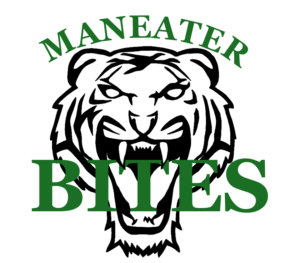March 5, 2024
The monthlong exhibition partnered local artists with the chefs behind some of Columbia’s most treasured cuisine
Illusionary, clashing colors and varying shapes, almost those of a TV screen that’s been hit by a baseball, take the form of a man wearing glasses. His mouth is enveloping, according to the work’s title, a lobster roll, but I chose to interpret the nearly indistinguishable food as an Ozark Mountain Biscuit Co. biscuit.
Curtis Hendricks, a Jefferson City-based photographic artist, curated “Lobster Roll Jazz.” It’s part of Columbia Art League’s “Devour” exhibition. Chef Paddy Jernigan, who works at Ozark Mountain Biscuit Co. and manages its food truck, partnered with Hendricks. Jernigan took “Lobster Roll Jazz” as inspiration for a hors d’oeuvres dish at the gallery’s “Let Them Eat Art!” event, further interweaving local art and food.
“Devour,” on display Jan. 16 through Feb. 23, satisfies perceptively insatiable cravings through mixed media. In mediums ranging from photography to acrylic paint to clay sculpture, the artists took risks from myriad angles. The exhibit honed in on the charm of local cuisine and versatility of inexplicably irresistible foods, while zooming out to illustrate the dangers of American fast food culture that often remain unacknowledged for convenience’s sake.
Columbia-based painter Ken Nichols’ “A Picture of my Brain Making Healthy Choices,” the exhibit’s first prize winner, depicts a social stigma around what is perceived as a healthy diet. My eyes were drawn to the juxtaposing half-eaten apple and peanut butter cup with one bite taken out of it.
Though the physical amount of food eaten in this image varies strongly — as more of the apple has been eaten than the peanut butter cup — the figure in the painting has a king size Reese’s tied to its back. Allowing viewers access to see one’s brain personified, Nichols lays out his perception of socially acceptable nutritional quantities. He punctures the idea of convenience culture in American food, subtly illustrating an acknowledgement of its harm and the effort one must make to facilitate a healthier lifestyle.
Creating artistic portraits of food can solidify the perspective of the creator. Whether one stores boxed mac and cheese on a shelf at a grocery store or transcends its taste into a work of art, there is always an element of mysteriosity. Where the grocery store display came from, how taste perception inspires creation and how that perception varies to impact the life of said store display are always ambiguous.
Works like Michelle Marcum’s “Danger Noodle” and Brandy Tieman’s “Better Off Fed” utilize print and acrylic, respectively, to illustrate the consumer’s bird’s-eye view on American food manufacturing.
Marcum’s “Danger Noodle” shape-shifts food into a living entity — albeit transcending into the carbohydrate realm with boxed mac and cheese. Utilizing the versatility of the noodle’s near concentric form, a macaroni entity is seemingly portrayed as evil and mysterious with cheese spurting from its joints.
Phrases like “dangerously cheesy” and “made of 100% box macaroni and cheese” illustrate the guilty pleasure that comes with consumption of mass-produced foods branded solely for taste, made with ingredients unfamiliar to the average human mind.
“Better Off Fed” reverses the paradigm of United States meat production to personify the commodity. In this story, vagueness adds clarity; it warns “some ingredients may not be suitable for people” as Tieman narrows the scope of animal rights advocacy by adding humanlike vigor to mystery meat and dismissing its consumer as better off dead.
In this regard, the “Devour” exhibit explores the various lenses of food production. Artists accentuated the mediums through which they expressed a fascination with the culinary experience as they strayed away from the broader scope of mass production.
Columbia-based fiber artist Pamela Gruer magnifies the artichoke in “Vessel for Butter,” an organlike model that emphasizes the ways in which a supplement adds a pulsation of flavor. Observing the collection of hearts, I imagined a network of veins and arteries creating a cyclic juicy pump of flavor. Tyler Pierson’s “Euphoric Burger” achieves a similar objective, fusing telltale signs of human hunger with a seemingly endless trove of juicy meat and melted cheese.
Romanticization of food, zooming in on the elements of delight, was a common theme at the exhibit both in depictions of foods and the human emotions surrounding hunger. Kelly Durante’s “Mouthgasm” is a partnered work with Trish Sieckmann, pastry chef and owner of TS Sweets. The work is a warm gradient of hexagons almost reminiscent of honeycomb’s crunchy, soft and sweet fusion. It’s an emphasis on hunger of multiple dimensions — the euphoria that comes with taking your first bite of a meal after a long day, and the warmth of chewing on something sweet.
Food is largely perceived as a necessity of the human experience. It’s vital to our survival, and necessary for our happiness. But few reinforce this perspective the way “Devour” does while embracing the ramifications of food’s subsequent industrialization.
From mystifying to mouthwatering, the exhibition is all-encompassing of the ways we consume food. Willful ignorance is less of a factor the more we localize and romanticize.
Edited by Annie Goldman | agoldman@themaneater.com
Copy Edited by Logan Gee and Briana Iordan | biordan@themaneater.com
Edited by Sophie Rentschler | srentschler@themaneater.com


Comments
The Maneater has the right to remove comments that do not comply with policies surrounding hate speech.